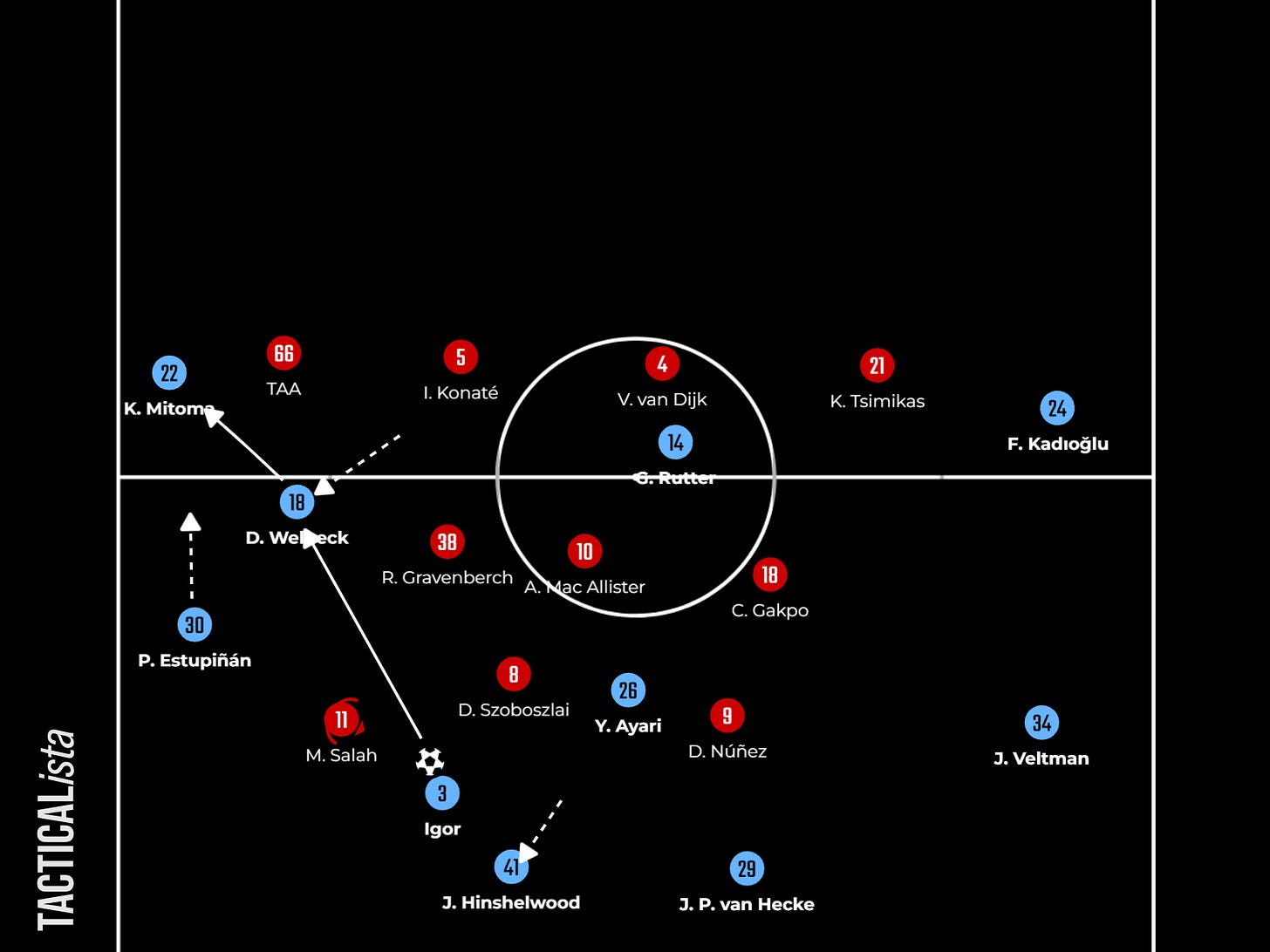Brighton & Hove Albion F.C: Fabian Hürzeler Turned Out To Be The Best Successor of Roberto De Zerbi
Tactical analysis of Brighton & Hove Albion under Fabian Hürzeler.
Roberto De Zerbi left Brighton by the end of the 2023/24 season. The Italian coach brought in an enthralling, eye-catching, and conspicuous playing style that took the Seagulls to levels they never attained before. Brighton received all the praise for the brave football they performed. Pep Guardiola described them as the best team in the world in the construction phase. A high-risk, high-reward buildup that deceived opponents to press and progress through their blocks, generating artificial transitions.
After the departure of the Italian coach, Anthony Grant Bloom, Brighton's chairman went on a mission to search for Roberto De Zerbi's successor. A new coach who suits the club’s vision based on an accurate and meticulous talent recruiting strategy, conserving the main playing principles. Out of nowhere, Brighton recruited the German coach, Fabian Hürzeler, coming from St Pauli.
We bring you the need to know about how Brighton plays under Fabian Hürzeler. How they construct their attacks from the back. How they create chances and How they defend without the ball.
Build-Up phase
Brighton built their attacks by splitting the two center-backs wide alongside the goalkeeper, allowing the fullbacks to push high up the pitch. Depending on the opposition press, Brighton fullbacks decide whether to narrow inside or hold the width of the pitch. In the middle of the park, Fabian Hürzeler deploys three midfielders on paper. On the ground, two of the trio form double pivots, whereas the other advances down the inside channels to help in the progression phase. With Fabian Hürzeler, Brighton kept the tradition of using the striker to drop deep, luring defenders to generate space behind or to be a target to progress over relying on his lay-offs.
Here, the fullbacks have two specific missions. Ferdi Kadıoğlu tucks inside, sneaking behind Jadon Sancho to receive Adam Webster's pass and take his team up the field. On the other side, Pervis Estupiñán switches positions with the midfielder, Jack Hinshelwood, and sprints down the left inside channel toward the byline, waiting for Mitoma to feed him behind and cut the ball back.
Brighton also uses ball carries to walk through the press. Having players like Carlos Baleba, who sniffs free spaces, is press-resistant, and can easily turn with the ball, leaving his marker in his wake, makes the opposition press null and useless. Brighton is ranked as the seventh team in the Premier League that relies on carries, with 368.1 per ninety minutes, and the fifth team counting on progressive carries, with 20.5 per game.
According to Fbref, Jan Paul Van Hecke, Pervis Estupiñán, and Carlos Baleba are three of the most players in Brighton who counted on carrying the ball on numerous occasions, as they accumulated 16, 14, and 13 progressive carries per game successively until now. Fabian Hürzeler’s system helped them find space so they could hold the ball for distances, taking their team up top.
Here, Jack Hinshelwood comes deep toward the ball side drawing Chris Wood's attention and vacating the left side for Lewis Dunk to exploit. Not only that, but the left back, Pervis Estupiñán, running down the left inside channel, dragged Callum Hudson-Odoi with him, allowing Lewis Dunk to carry the ball for more distances and feed him behind.
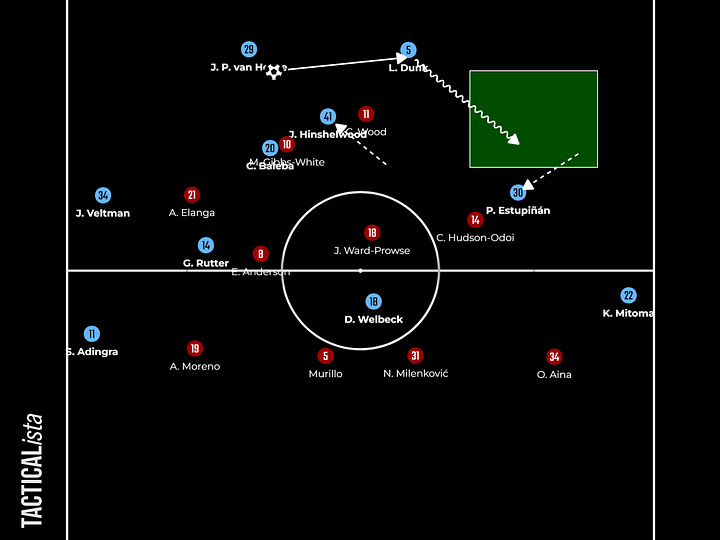
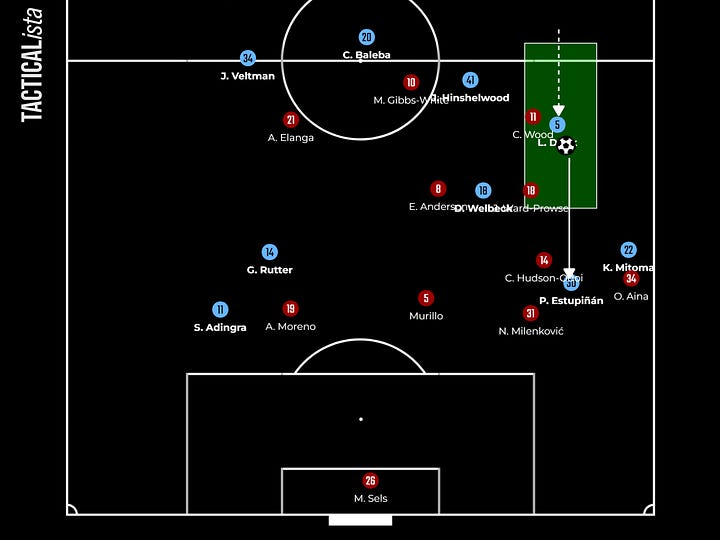
The third-man combination remains one of Brighton's marquees in the construction phase. In this example, Georginio Rutter shifts across, taking Elliot Anderson with him, and Jack Hinshelwood, having time and space in his favor, drops behind the first line of Nottingham Forest’s press, with Chris Wood having no clue about what is happening behind him, so Brighton backline has access to Hinshelwood. In addition, the fullbacks and the midfielders’ positions stretch Forest Block vertically. A quick combination between Van Hecke, Hinshelwood, and Baleba enables the latter to carry the ball up the field and fire a shot.
When facing compact blocks, Brighton attempted to progress around, placing the fullbacks in narrow positions to attract the opposite wingers and open the passing lane to the playmaker who shifted across. Once he received the ball, he carried it to feed the winger to play crosses or cutbacks.
Nottingham Forest defended in a 4-4-2 medium block, with the wingers Anthony Elanga and Callum Hudson-Odoi to jump over the fullbacks. The attacking midfielder, Georginio Rutter moving across between the lines, created a numerical superiority in the middle of the park and generated a passing angle for Van Hecke to supply him. That pushed Nottingham Forest’s block backward and enabled Rutter to hand the ball to Adingra and run to crash the box in order to receive the latter’s cross.
The striker dropping between the lines remains one of Brighton's assets to bypass the opponents’ press. Dani Welbeck, receiving with his back to the goal and holding the play are key components to Brighton's progression. Here, Tottenham press forces Lewis Dunk to pass the ball to Veltman near the touchlines. Udogie jumps over, and Tottenham players swarm behind. That stretches their lines vertically and leaves them in a numerical match in the backline. Dani Welbeck seizes the opportunity to collect Veltman's pass over the block, wins his duel against Romero, and hands the ball to Minteh. The latter immediately supplies Welbeck before Romero catches up to him. Brighton crashes the box with four players facing four Tottenham cogs.
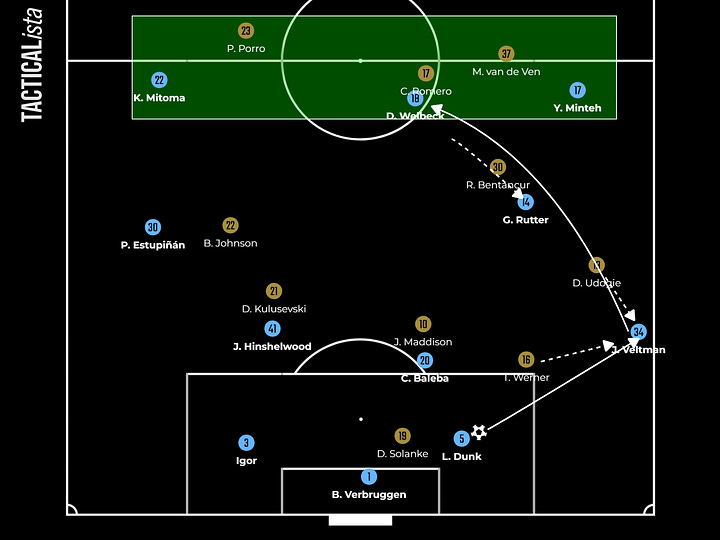

In another example against Liverpool, Mohamed Salah adjusts his body to close off the passing angle on Igor to progress around using the left-back, Pervis Estupiñán. Dominik Szoboszlai and Darwin Núñez partner to prevent the central progression. Therefore, Dani Welbeck sneaks behind Ryan Gravenberch, moving across to receive Igor’s pass and feed Mitouma on the wing.
Staying on the same perspective, Igor plays a quick pass to the left-back, Estupiñán, who holds the touchlines. The center is closed as Mohamed Salah operates near Yasin Ayari, with Dominik Szoboszlai and Darwin Núñez in full readiness to jump over if the ball is played to Jack Hinshelwood. Thus, playing around is a must. In addition, Dani Welbeck and Kaoru Mitoma come deep, moving oppositely and diagonally. The first dashes deep to combine, dragging Konaté with him and instantly vacating his space for Mitoma to exploit and switch the play to the other side.


Dropping one of the double pivots behind the ball to the backline to lure and entice the press using the ballholder's body fake insinuations is another outlet for Brighton to walk through the blocks. For instance, Jack Hinshelwook joined the defense and baited Darwin Núñez to press. Moreover, Jan Paul Van Hecke's body language insinuated his intention to play the ball sideways, which drove Dominik Szoboszlai to adjust his posture to be ready if the ball went to the left side. That won Ayari space and time to receive and ship the ball to Kadıoğlu, who drifted inside and switched the play to Mitouma.


With soft ball touches, Verbruggen enticed Darwin Núñez to start the press. The latter responded with an arced run to close the passing lane toward Van Hecke. However, a third-man combination with Jack Hinshelwood unlocked the access to the right side. In the meantime, Yasin Ayari diagonally ran behind Szoboszlai, as the latter was outnumbered at the edge of the box. Therefore, Van Hecke easily found a free man in midfield to progress through, making Liverpool's press useless. Ayari spotted Rutter sprinting down the center in isolation against Virgil Van Dijk as Welbeck dropped deep, dragging Konaté with him, leaving the defense exploitable.
Chances creation
On the left side, Brighton relies on rotations and position interchanges between the winger, the left-back, and the striker. Such movements disrupt the opposition's attention and generate spaces between position-swapping moments as the opponents need time to comprehend and cognitively adapt to the sudden events that are occurring. Brighton takes advantage of the processing period to combine and exploit spaces before the opponents wrap their heads around.
Here, Tottenham defends in a 4-1-4-1 medium block. Igor carries the ball forward until Mitouma inverts, drawing Pedro Porro's attention and vacating the wide channel for Estupiñán to receive. In the meantime, Cristian Romero tracks Dani Welbeck who drops between the lines. However, he ditches the idea when Mitouma runs inside. Pedro Porro jumps over Estupiñán but is late, and his effort isn’t enough to stop the lateral pass toward the Japanese winger, who feeds Rutter between Tottenham center-back and left-back.


Using long balls behind the opponent’s block is an option for Brighton under Fabian Hürzeler to arrive at the final third. According to Fbref, the Seagulls completed 37.7 long balls per ninety minutes in the Premier League 2024/25 season. That saw them the fourth team in the league, recalling long balls after Everton, Fulham, and Brentford in the third spot. In detail, in the 2023/24 season, Brighton attempted to play 56.9 long balls, 240.1 passes with medium range, and 328.1 short passes in second place after Manchester City. Until the time of writing, Brighton under Fabian Hürzeler attempted 63 long passes, 200.1 medium passes, and 231.5 short passes, taking into account the small number of games played until November 2025. Adding to that, Brighton play their long pass with a rate of accuracy of 59.9%, with Manchester City the only team overriding them in this regard with 66.4%.
For example, Manchester City blocks off the central channel, lining up in a 4-4-2 medium shape. Joao Pedro takes place down the left inside channel, with Kauro Mitoma hugging the touchlines. That generates numerical superiority as the pair overloads Kyle Walker on the left side. Jan Paul Van Hecke spots the situation and feeds Joao Pedro, who sprints to receive.
Brighton also generated chances from quick and fast build-ups catching the opponents off guard while re-adjusting their positioning. Against Liverpool, Pervis Estupiñán inverted inside vacating the wide channel for Kauro Mitoma to come deep pulling Alexandar Arnold out of his position. Igor took advantage of the angle opened to access the Japanese winger due to Mohamed Salah's inside position. In the meantime, Estupiñán traveled toward the vacant space behind Arnold allowing Yasin Ayari to advance and collect Mitoma’s pass to progress. Leaving Estupiñán unmarked Ryan Gravenberch, Alexander Arnold, and Dominik Szoboszlai swarmed to counter-press and block off all passing options. Nevertheless, they didn’t fulfill the mission and Yasin Ayari fed Estupiñán on the left side who spotted Dani Welbeck sneaking behind Joe Gomez. Brighton striker crossed the ball and Virgil Van Dijk cut its path.

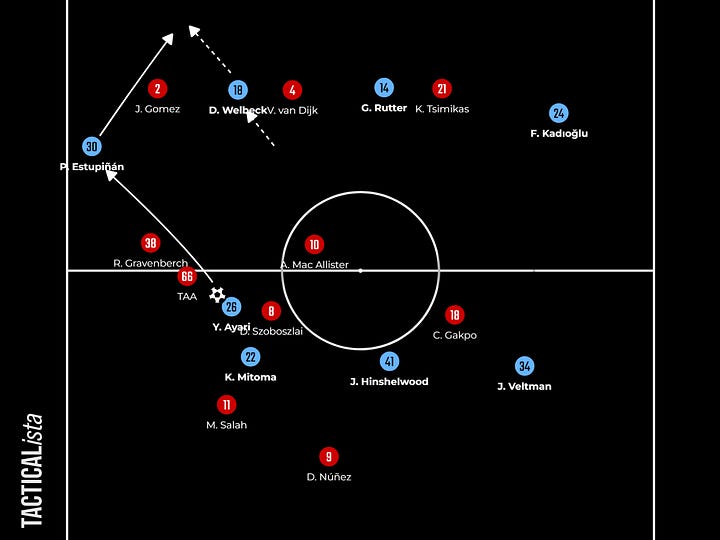
Building from the right to arrive at the final third on the left proved a welcome part of Brighton buildups to create chances. In addition, involving the goalkeeper in the construction phase allowed Fabian Hürzeler’s team to have more bodies between the lines. Here, Verbruggen steps up, allowing Van Hecke to operate as a situational right-back, whereas Veltman pushes on and inverts between the lines. Darwin Núñez is occupied by Jack Hinshelwood, and Cody Gakpo stays between Brighton center-back and right-back down the right inside channel. Time and space are the most valuable assets in football, as all the coaching strategies evolve around these two factors. Liverpool press allows Van Hecke the time and space to carry the ball. Furthermore, Cody Gakpo blocking off the passing lane, Darwin Núñez shifting toward Van Hecke, and Curtis Jones traveling to catch up with Veltman supply the latter with time and ground to receive. Brighton progresses to the middle third, so Jack Hinshelwood joins Ferdi Kadıoğlu and Veltman creating a numerical superiority on the left side. That saw them easily combine and push Liverpool's last line backward. Thanks to Gravenberch being late on tracking back, Hinshelwood has the space to carry the ball and feed Rutter who spots Mitoma on the left. Dani Welbeck's diagonal run, to drag Joe Gomez with him, puts Mitoma in one-versus-one against Trent Alexander Arnold.


In another example against Manchester City, Fabian Hürzeler makes Carlos Baleba operate as a single pivot allowing Hinshelwood to push on. Pervis Estupiñán holds the width of the pitch and Mitouma drifts inside. Dani Welbeck and Georginio Rutter's vertical, opposite movements offer Brighton’s backline a target man between the lines to receive and switch the ball to Mitoma. The latter feeds Estupiñán on the left wing to play the ball across.
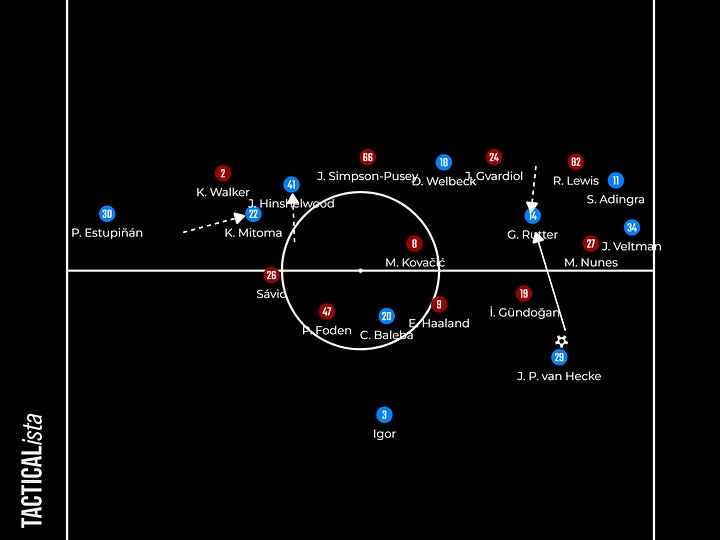
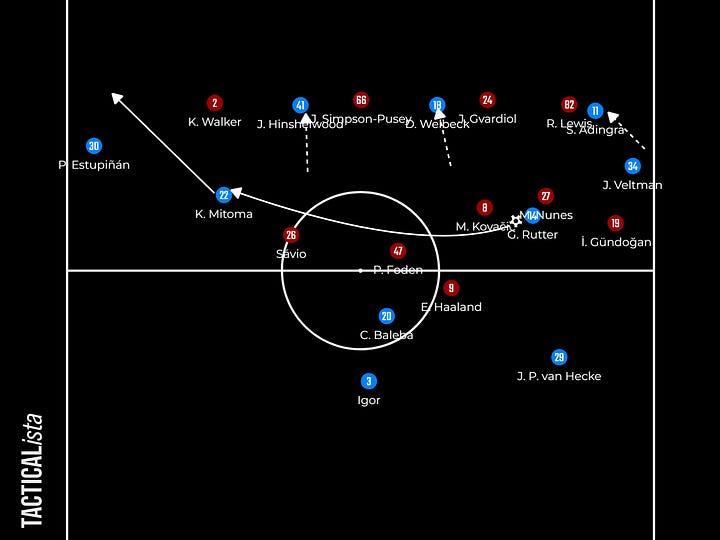
The third-man combination is another asset for Brighton to create chances. Against Manchester City, Brajan Gruda and Pervis Estupiñán position forced Phil Foden and Matheus Nunes to stay narrower. Erling Haaland and Kevin De Bruyne blocked the access to Carlos Baleba. Van Hecke noticed the gap between Manchester City's double pivots as the citizens’ block was not compact horizontally. Therefore, a third-man combination took place to immediately switch the play to Kauro Mitoma on the left side where Brighton created a wide overload by making Estupiñán hug the touchlines and Mitoma tuck inside running behind Phil Foden. Kyle Walker took charge of Joao Pedro who spotted Matt O’Riley’s movement behind Simpson-Pusey.


Also, Fabian Hürzeler's team generated goalscoring chances exploiting opponents from the central corridor. The second goal of Brighton against Manchester City embodied that. Here, Pep Guardiola's team defends in a 4-4-2 shape. Dani Welbeck separates himself from Joško Gvardiol, drops between the lines, and lays Carlos Baleba's line-breaking pass to Joao Pedro. Brighton striker’s in-depth run drags Gvardiol stretching the space between the latter and Rico Lewis for Matt O’Riley to attack. Joao Pedro delivers a through-ball and O’Riley puts it home.


Pressing high
Dani Welbeck usually initiates the press, curving his run to force the opposition to play wide. One of the three in midfield (Jack Hinshelwood below) jumps over the center-back who has the ball and screens with his shadow the opposite defensive midfielder. The winger (Mitoma) occupies the opposite fullback. Cole Palmer tends to shift wide here, so Mats Wieffer follows him near the touchlines, and Lewis Dunk steps up to prevent Nicolas Jackson from holding the play. The far-side winger narrows significantly as Fabian Hürzeler wants to lock the ball side and regain it close to the opposition goal to create chances or recycle it again.

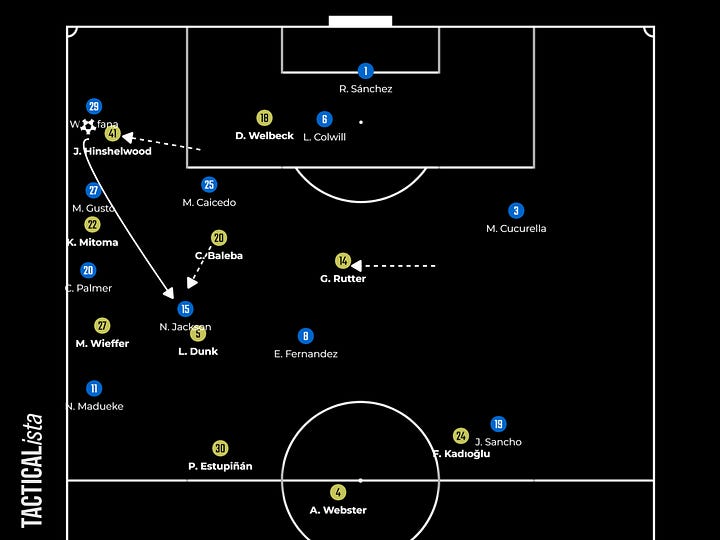
When pressing high, Brighton tries to set wide traps and then swarm in units to regain the ball. If the opportunity is available to transition once they cut the ball off, they seize it; otherwise, Brighton recycles again. Here, Dani Welbeck closes off access to Bentancur and Mitoma keeps himself ready to jump over the right back, Pedro Poro. Georginio Rutter intentionally takes a distant position from Van De Ven to lure Cristian Romero. Once the pass gets released, a fluid-traveling and follow-up chain takes place. Georginio Rutter leaves his man for Dani Welbeck and turns his attention to Mickey Van De Ven. Jack Hinshelwood takes charge of Dejan Kulusevski, who is drifting toward the ball side. Yankuba Minteh hands the inverting left back, Udogie to Carlos Baleba, and jumps over James Maddison, who shifts wide. The latter has no backward and sideways options, as the Brighton unit shuts down the opposite side of the pitch. So, Maddison is forced to pass the ball to Udogie. As a result, Carlos Baleba extracts the ball, winning a physical duel against Tottenham's left-back and regaining possession.


Setting in a block
When defending, Brighton under Fabian Hürzeler looked to set up a 4-4-2 block in which the wingers stepped down to the second line to cover the opposite fullbacks. The front two blocked off access to the central corridor and jumped over the center-backs, shadow-marking the midfielders behind them. In the case of the opposition playing with a three in midfield, one of the front two operated close to the single pivot while the other moved toward the ball holder. The wingers joined the second line to occupy the opposite fullbacks, and the double pivots assumed the responsibility of the midfielders to prevent them from walking through their block. Brighton fullbacks dealt with the opposite wingers. In addition, the center-backs are aggressive and proactive, following strikers, who tend to drop off and play as a target man to progress. That forces the opposition to play around near the touchlines, where Brighton relies on the wingers and the fullbacks’ intensity to stop the opponents’ intentions (combinations and overlaps).
Takeaways
Roberto De Zerbi’s traits are still tangible in Brighton’s playing style, with Fabian Hürzeler adding his touches. The German coach conserved the neat and quick build-up that Brighton executed with De Zerbi. In addition, the Seagulls rely more on long balls as a way to arrive at the final third. Positional rotations and wide overloads are repeated patterns to generate suitable situations for crosses or cutbacks to create chance. Out of possession, the team is ranked fourth behind Tottenham, Arsenal, and Liverpool in terms of PPDA metric with 9.45. Brighton usually sets wide traps and swarms to regain the ball. Moreover, they line up in a 4-4-2 compact block, closing off the center and giving up the wide channels.
To conclude, Fabian Hürzeler is delivering impressive work with Brighton, leading them to sixth place in the Premier League (by the time of writing) with 19 points equal to Chelsea, Arsenal, and Nottingham Forest, with a clear playing style enabling the Seagulls to stand toe-to-toe against the English mammoths. Still, 27 games to play for Brighton to accurately assess the team under Hürzeler on a seasonal basis.
If you’re enjoying what we are producing—whether it’s an analysis, scouting, or opinion—Please subscribe, leave a comment, and drop a like. It helps us know that people out there value the work, and it boosts us on the Substack algorithms.
“Sharing knowledge is not about giving people something, or getting something from them. That is only valid for information sharing. Sharing knowledge occurs when people are genuinely interested in helping one another develop new capacities for action; it is about creating learning processes.”~Peter Senge









